TC
Auto Added by WPeMatico
Auto Added by WPeMatico
Early this year the Sustainable Oceans Alliance announced it would be starting its own accelerator with a focus on conservation. The nonprofit has just announced the Ocean Solutions Accelerator’s first wave of startups: a particularly varied and international lineup that’s easy to root for.
You may also remember that the SOA was one of the beneficiaries of the mysterious Pineapple Fund, administered by a mysterious cryptocurrency multimillionaire. No doubt that has helped get the accelerator on its feet in good time.
The startups — which I’m getting to, be patient — will receive an initial investment to cover the cost of relocating to the Bay Area for eight weeks this summer. There they will receive the loving care of the collection of academics, founders, officials and others in or around the Alliance, plus some important “personal development and executive training” intended to keep your company alive long enough to ship a product.
Interestingly, applications were only open to founders 35 years and under, presumably to get that young blood into the conservation game. Here are the five companies selected to take part:

SafetyNet, from London, makes light-emitting devices that attach to fishing nets and can be programmed to attract or discourage certain kinds of fish. This prevents a boat from catching — and subsequently throwing away — thousands of the wrong fish, a huge waste.
CalWave came out of Berkeley a couple of years ago and has been testing and refining its wave-harvesting renewable energy system, and in fact won a big Department of Energy grant just last year. Now presumably the team is looking to go from prototype to product and do some big installs.

Loliware’s edible cups.
Loliware has created seaweed-based straws and cups that are so compostable you can do it yourself — like, in your mouth. The items last for a day in a drink (or with a drink in them) but when you throw it away it’ll totally dissolve in about two months — or you could literally eat it. The New Yorkers were on Shark Tank and I’m guessing they ate one on camera. You can already order them on Amazon and people say they’re actually pretty tasty.
Etac, a Mexican company from Culiacan, has few details on its site, but SOA’s press release says the company “designs and produces functional nanomaterials for energy and environmental applications, such as oil spill and wastewater cleanup.” I believe them.
And because there can’t be an accelerator without a blockchain startup in it, there’s Blockcycle, based in Sydney, which aims to create a marketplace around waste materials that would normally go to the landfill but could also be valuable to recyclers, reusers and so on. (Turns out there was an uptick in blockchain applications after the Pineapple Fund thing.)
All five companies will present their ideas on September 11 at an event (specifically, a gala) timed to coincide with California Governor Jerry Brown’s Global Climate Action Summit in San Francisco. And then in October they’ll present again in Bali at the Our Ocean Youth Summit.
“These ocean entrepreneurs are a beacon of hope at a time when new, bold approaches are needed to fast-track innovation and sustain the health of our planet,” said SOA founder and CEO Daniela Fernandez. “By supporting these incredible startups, we are encouraging young people to take ownership of the environmental threats facing their communities, bet against consensus and re-invent existing markets to benefit, instead of harm, our climate, and ocean.”
Powered by WPeMatico
Ubisoft has implemented a new system in Rainbow Six Siege that bans players for using toxic language in the text chat, according to PC Gamer.
Yesterday, a number of players started whining about being temporarily banned from the game after using a racist or homophobic slur in the text chat. The first offense results in a 27 minute ban. Second and third offenses will cost players 2 hours of game time, and any following toxic language will result in an official investigation and potentially a permanent ban from the game.
Like most games, Ubisoft’s Rainbow Six Siege has a Code of Conduct that forbids “any language or content deemed illegal, dangerous, threatening, abusive, obscene, vulgar, defamatory, hateful, racist, sexist, ethically offensive or constituting harassment.” However, most games do close to nothing to enforce these rules, which has led to an overwhelmingly toxic gaming community overall.
This new banning system doesn’t come out of the blue. Ubisoft has been talking about removing toxic language from the platform for a while. In fact, the dev team wrote in April that it has plans to add new features to limit the use of offensive language on the game.
From the April post:
Our team is working on the creation of an automated system that will censor text chat in game based on a chat filter list. This will replace words that have been identified as offensive and provide players with a notification that their language was found to be unacceptable. We will also be tracking the number of times players trigger this filter and will take action as necessary for players that are intentionally having a negative impact on other player’s gaming experience.
The current iteration of the banning system doesn’t censor the offensive words in text chat but rather goes straight to the 27-minute ban.
The gaming world has grown into an increasingly toxic environment, as there has been little to no policing of users’ behavior and communication. But eSports and Twitch are putting gamers in the spotlight, and brand endorsements are a huge piece of the upward trajectory of esports. But no brand is going to get behind a gamer that uses homophobic or racial slurs.
Ubisoft says on Twitter that the ban system is still being updated and the team is taking feedback from the community to continue refining it, as well as punishing players who are cheating.
No system is perfect, but it is working as intended in a majority of the cases we’ve been seeing.
This is not our final update for dealing with toxicity — we will continue to observe and make changes and expansions as needed.— Rainbow Six Siege (@Rainbow6Game) July 16, 2018
Powered by WPeMatico
Dialpad announced a $50 million Series D investment today, giving the company plenty of capital to keep expanding its business communications platform.
The round was led by Iconiq Capital with help from existing investors Andreessen Horowitz, Amasia, Scale Ventures, Section 32 and Work-Bench. With today’s round, the company has now raised $120 million.
As technology like artificial intelligence and internet of things advances, it’s giving the company an opportunity to expand its platform. Dialpad products include UberConference conferencing software and VoiceAI for voice transcription applications.
The company is competing in a crowded market that includes giants like Google and Cisco and a host of smaller companies like GoToMeeting (owned by LogMeIn), Zoom and BlueJeans. All of these companies are working to provide cloud-based meeting and communications services.
Increasingly, that involves artificial intelligence like natural language processing (NLP) to provide on the fly transcription services. While none of these services is perfect yet, they are growing increasingly accurate.
VoiceAI was launched shortly after Dialpad acquired TalkIQ in May to take this idea a step further by applying sentiment analysis and analytics to voice transcripts. The company plans to use the cash infusion to continue investing in artificial intelligence on the Dialpad platform.

Post call transcript generated by VoiceAI. Screenshot: Dialpad
CEO Craig Walker certainly sees the potential of artificial intelligence for the company moving forward. “Smart CIOs know AI isn’t just another trendy tech tool, it’s the future of work. By arming sales and support teams, and frankly everybody in the organization, with VoiceAI’s real-time artificial intelligence and insights, businesses can dramatically improve customer satisfaction and ultimately their bottom line,” Walker said in a statement.
Dialpad is also working with voice-driven devices like the Amazon Alexa and it announced Alexa integration with Dialpad in April. This allows Alexa users to make calls by saying something like, “Alexa, call Liz Green with Dialpad” and the Echo will make the phone call on your behalf using Dialpad software.
According to the company website, it has over 50,000 customers including WeWork, Stitch Fix, Uber and Reddit. The company says it has added over 10,000 new customers since its last funding round in September, 2017.
Powered by WPeMatico
Centralized crypto exchanges like Coinbase are easy but expensive because they introduce a middleman. Not-for-profit project 0x allows any developer to quickly build their own decentralized cryptocurrency exchange and decide their own fees. It acts like Craigslist, connecting traders without ever holding the tokens itself. And instead of having to bootstrap their way to enough users trading tokens on their app alone so that there’s liquidity, 0x offers cross-platform liquidity between users on the different projects it powers.
The problem is the user experience of decentralized apps is often crappy compared to the consumer apps we’re used to across the rest of tech. From sign-in to recovering accounts to conducting transactions, it’s a lot more complicated than Facebook Login, PayPal, or Shopify. Bitcoin and Ethereum prices remain well below half their peaks because it’s difficult to do much with cryptocurrency right now. Until the decentralized infrastructure improves, the dreams of how blockchains can improve the world remain distant.
0x is trying to fix that by ensuring developers all don’t have to reinvent the exchange wheel.

It began as a for-profit exchange before the team recognized the massive usability gap. So instead it became a decentralized exchange protocol, and raised $24 million in an ICO for its ZRX token. That’s how relayers — the apps who use it to build exchanges for ERC20 tokens atop the Ethereum blockchain — can charge fees. It also gives those who collect the most a say in the governance of the protocol.
Some of the top projects on 0x like Augur and Dydx are going strong. Last week Coinbase announced it was exploring whether it might list ZRX and several other currencies for trade on its exchange, helping perk up the price after declines since the new year.

0x’s ZRX token price, via CoinMarketCap
Now 0x is putting some of its $24 million to work. It just hired former Facebook designer Chris Kalani to help it improve the usability of its APIs and the products built on top of them. His skills helped Facebook embrace mobile around its 2012 IPO. He then built Wake, raising $3.8 million for the design prototype sharing tool that let teams get instant feedback on their works-in-progress. Kalani sold Wake to design platform InVision in April, and after a few months assisting the transition, he’s joined 0x.
“There are very few designers involved in the [blockchain] space” Kalani tells me. “There’s not a lot of people who had worked on anything at a large-scale or from the consumer perspective. We’re focused on making crypto more approachable.”
 After talking to four leaders in different parts of the blockchain industry, the consensus was that 0x was an elegant protocol for spawning decentralized exchanges. But the question kept coming up about whether the project will be sustainable. The company doesn’t have to earn enormous amounts of revenue, but concerns about its longevity could scare away developers. One, who asked to remain anonymous, described 0x saying, “the best analogy is trying to monetize Linux.”
After talking to four leaders in different parts of the blockchain industry, the consensus was that 0x was an elegant protocol for spawning decentralized exchanges. But the question kept coming up about whether the project will be sustainable. The company doesn’t have to earn enormous amounts of revenue, but concerns about its longevity could scare away developers. One, who asked to remain anonymous, described 0x saying, “the best analogy is trying to monetize Linux.”
0x is open source, so it could be forked so developers can sidestep ZRX. 0x hopes that the shared liquidity feature will keep developers in line. It only works with the unforked version, and is now being used by 0x-powered projects, including Radar Relay, ERC dEX, Shark Relay, Bamboo Relay and LedgerDex.
While some centralized exchanges have suffered security troubles and hacks, those with stronger records like Coinbase continue to thrive while banking off high fees. That in turn lets them offer better liquidity and invest more in the user experience, widening the gap versus decentralized apps. “People trust Coinbase with large amounts of capital but they wouldn’t trust themselves,” Kalani admits. But he thinks it’s early in the game, and as users become more knowledgeable and comfortable with holding their own tokens for use on decentralized exchanges, 0x and ZRX will thrive.

There’s also competition within the decentralized exchange space from Kyber’s liquidity network, and AirSwap’s peer-to-peer exchange marketplace. But for any of these to thrive, the mainstream crypto owner will have to get better educated. That could fall to 0x.
One alternative path for the not-for-profit would be selling developer services and consulting to those building on top of it. Or it could always do another ICO. But for now, there are a lot of projects out there that don’t want to foot the upfront cost to build their own secure and compliant exchange from scratch. Kalani concludes, “The way Stripe allowed developers and businesses to build on top of it, and not have to worry about regulatory issues and all the infrastructure necessary to take payments, I think 0x is going to do something similar with exchanges for crypto.”
Powered by WPeMatico
Apple’s App Store continues to outpace Google Play on revenue. In the first half of the year, the App Store generated nearly double the revenue of Google Play on half the downloads, according to a new report from Sensor Tower out today. In terms of dollars and cents, that’s $22.6 billion in worldwide gross app revenue on the App Store versus $11.8 billion for Google Play – or, 1.9 times more spent on the App Store compared with what was spent on Google Play.
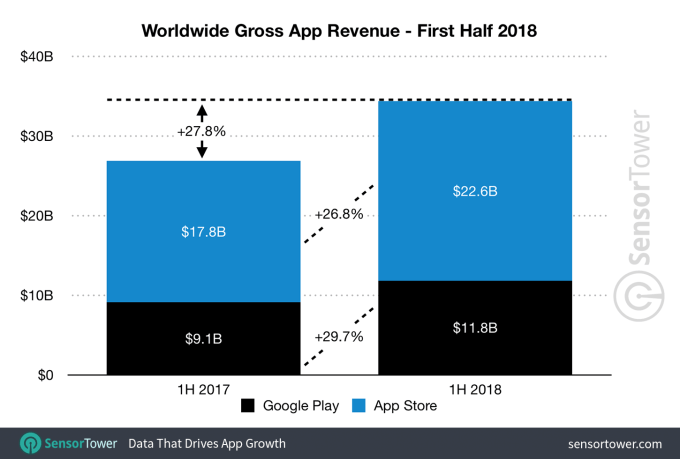
This trend is not new. Apple’s iOS store has consistently generated more revenue than its Android counterpart for years due to a number of factors – including the fact that Android users historically have spent less on apps than iOS users, as well as the fact that there are other Android app stores consumer can shop – like the Amazon Appstore or Samsung Store, for example. In addition, Google Play is not available in China, but Apple’s App Store is.
Last year, consumer spending on the App Store reached $38.5 billion, again nearly double that of Google Play’s $20.1 billion.
As the new figures for the first half of 2018 indicate, consumer spending is up this year.
Sensor Tower estimates it has increased by 26.8 percent on iOS compared with the same period in 2017, and it’s up by 29.7 percent on Google Play.
The growth in spending can be partly attributed to subscription apps like Netflix, Tencent Video, and even Tinder, as has been previously reported.
Subscription-based apps are big businesses these days, having helped to boost app revenue in 2017 by 77 percent to reach $781 million, according to an earlier study. Netflix was also 2017’s top non-game app by revenue, and recently became ranked as the top (non-game) app of all-time by worldwide consumer spend, according to App Annie’s App Store retrospective.
Many of the other all-time top apps following Netflix were also subscription-based, including Spotify (#2), Pandora (#3), Tencent Video (#4), Tinder (#5), and HBO NOW (#8), for example.
And Netflix is again the top non-game app by consumer spending in the first half of 2018, notes Sensor Tower.
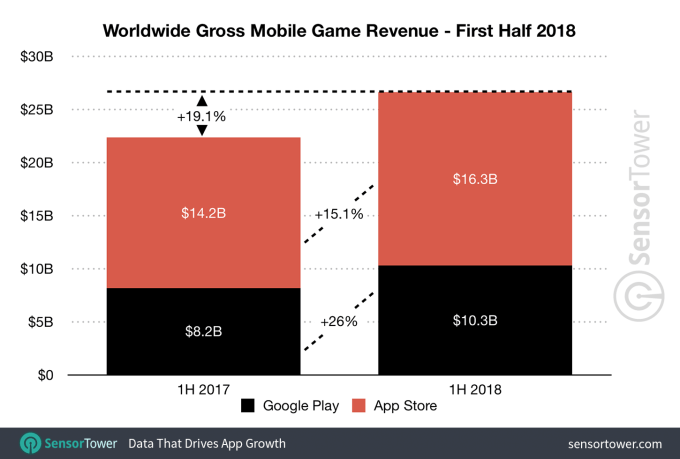
Game spending, however, continues to account for a huge chunk of revenue.
Consumer spending on games grew 19.1 percent in the first half of 2018 to $26.6 billion across both stores, representing roughly 78 percent of the total spent ($16.3 billion on the App Store and $10.3 billion on Google Play). Honor of Kings from Tencent, Monster Strike from Mixi, and Fate/Grand Order from Sony Aniplex were the top grossing games across both stores.

App downloads were also up in the first half of the year, if by a smaller percentage.
Worldwide first-time app installs grew to 51 billion in 1H18, or up 11.3 percent compared with the same time last year, when downloads were then 45.8 billion across the two app stores.
Facebook led the way on this front with WhatsApp, Messenger, Facebook and Instagram as the top four apps across both the App Store and Google Play combined. The most downloaded games were PUBG Mobile from Tencent, Helix Jump from Voodoo, and Subway Surfers from Kiloo.
Google Play app downloads were up a bit more (13.1 percent vs iOS’s 10.6 percent) year-over-year due to Android’s reach in developing markets, reaching 36 billion. That’s around 2.4 times the App Store’s 15 billion.
Despite this, Apple’s platform still earned more than double the revenue with fewer than half the downloads, which is remarkable. And it can’t all be chalked up to China. (The country contributed about 31.7 percent of the App Store revenue last quarter, or $7.1 billion, to give you an idea.)
Sensor Tower tells TechCrunch that even if China was removed from the picture, the App Store would have generated $15.4 billion gross revenue for first half of 2018, which is still about 30 percent higher than Google Play’s $11.8 billion.
Powered by WPeMatico
In honor of World Emoji Day (yes, that’s a thing), Apple is previewing some of its upcoming emoji. Later this year, Apple’s emoji set will feature people with a variety of hairstyles and colors, including curly hair, red hair and white hair. What you’re about to see are simply Apple’s take on emoji that were previously approved by the Unicode Consortium’s emoji subcommittee.

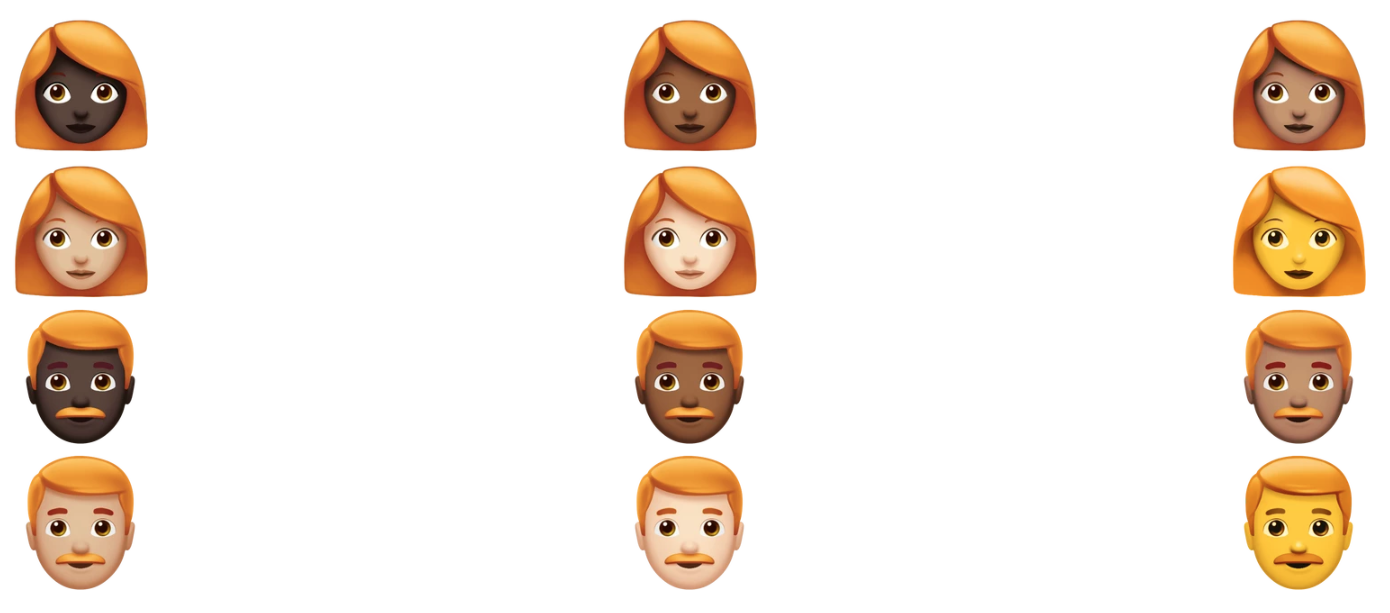
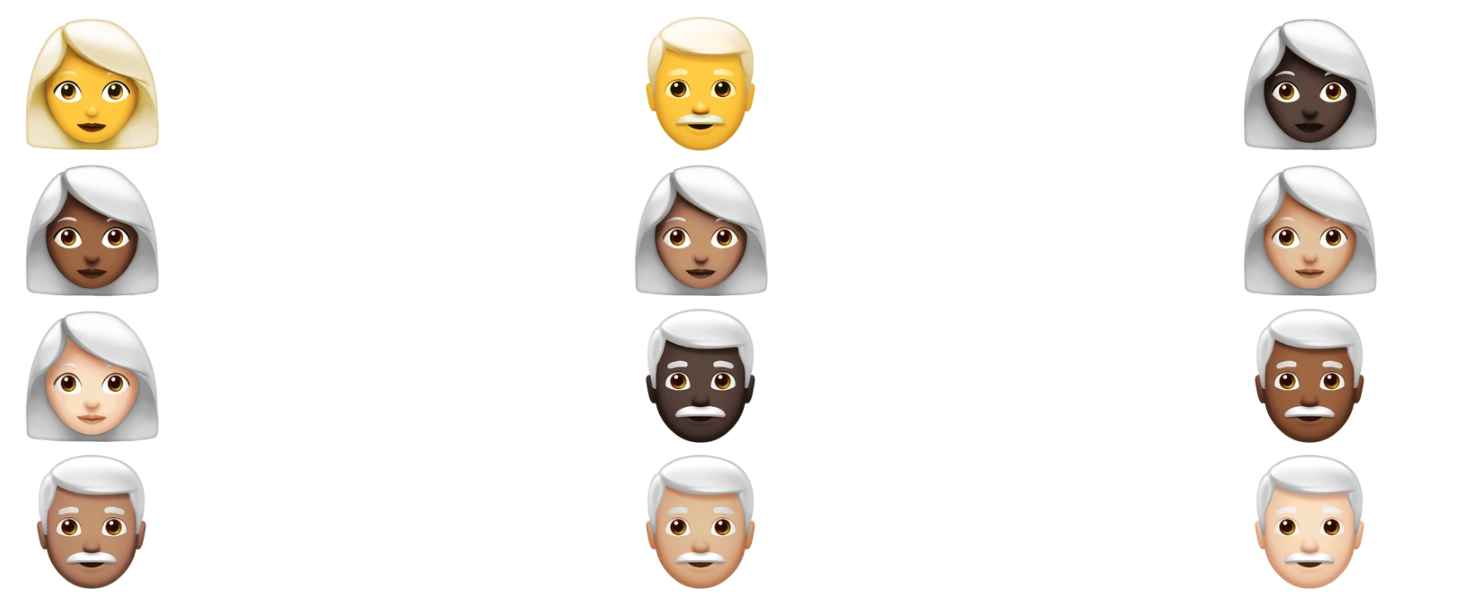

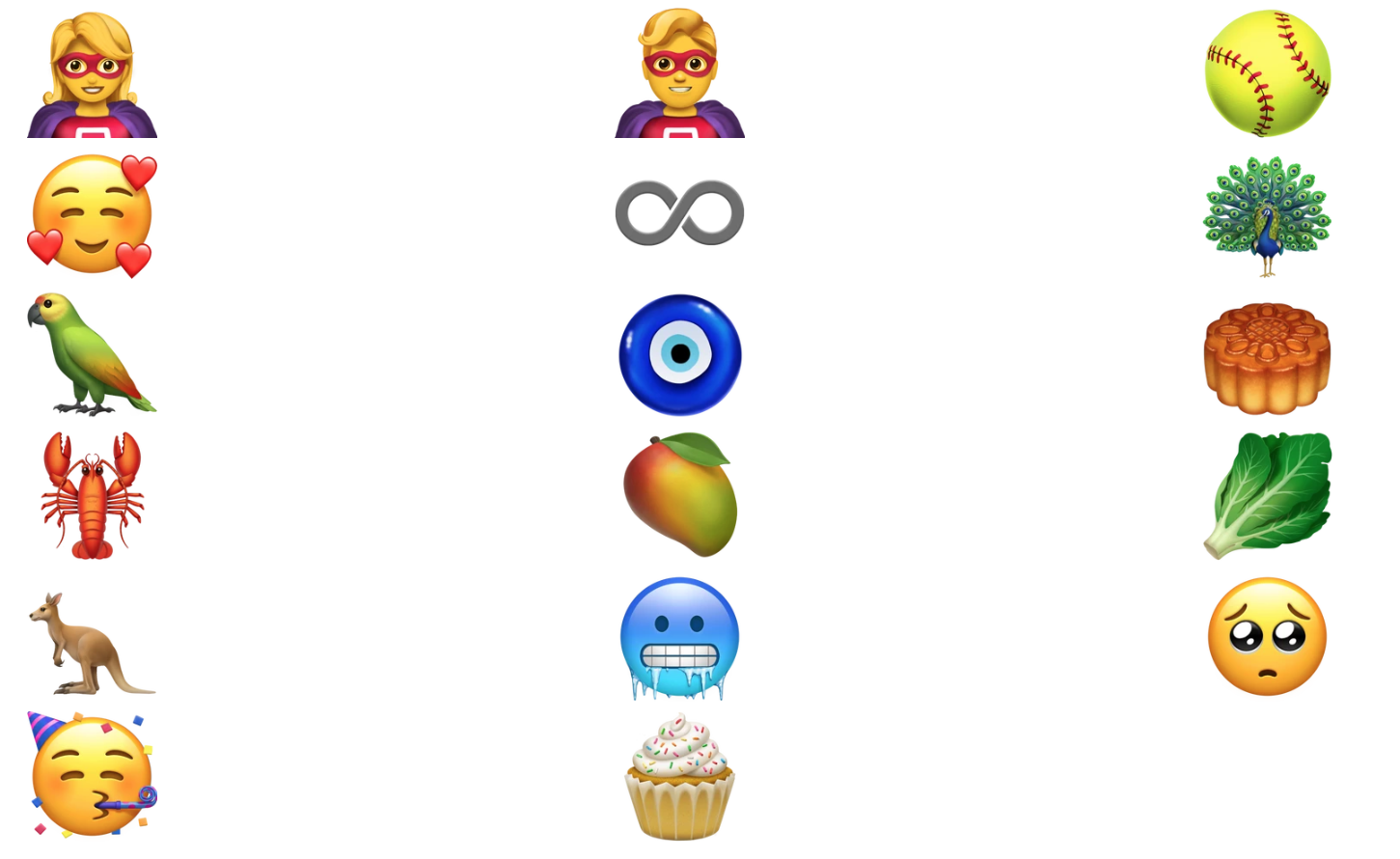
Back in March, Apple proposed new emojis to represent people with disabilities in Unicode’s next batch of emoji. Then in May, Unicode announced some of the draft candidates for its next emoji release in Q1 2019 to include some of Apple’s proposed emoji, which featured a guide dog, an ear with a hearing aid and more. If you want to hear more about what goes into emoji approval, be sure to check out this interview with Jeremy Burge, vice-chair of the Unicode Emoji Subcommittee.
Powered by WPeMatico
Not far from Tel Aviv a drone flies low over a gritty landscape of warehouses and broken pavement. It slowly approaches its home — a refrigerator-sized box inside a mesh fence, and hovers, preparing to dock. It descends like some giant bug, whining all the way, and disappears into its base where it will be cleaned, recharged and sent back out into the air. This drone is doing the nearly impossible: it’s flying and landing autonomously and can fly again and again without human intervention — and it’s doing it all inside a self-contained unit that is one of the coolest things I’ve seen in a long time.
The company that makes the drone, Airobotics, invited us into their headquarters to see their products in action. In this video we talk with the company about how the drones work, how their clients use the drones for mapping and surveillance in hard-to-reach parts of the world and the future of drone autonomy. It’s a fascinating look into technology that will soon be appearing in jungles, deserts and war zones near you.
Powered by WPeMatico
Need to resize a video for IGTV? Add subtitles for Twitter? Throw in sound effects for YouTube? Or collage it with other clips for the Instagram feed? Kapwing lets you do all that and more for free from a mobile browser or website. This scrappy new startup is building the vertical video era’s creative suite full of editing tools for every occasion.
Pronounced “Ka-pwing,” like the sound of a ricocheted bullet, the company was founded by two former Google Image Search staffers. Now after six months of quiet bootstrapping, it’s announcing a $1.7 million seed round led by Kleiner Perkins.

Kapwing hopes to rapidly adapt to shifting memescape and its fragmented media formats, seizing on opportunities like creators needing to turn their long-form landscape videos vertical for Instagram’s recently launched IGTV. The free version slaps a Kapwing.com watermark on all its exports for virality, but users can pay $20 a month to remove it.
While sites like Imgur and Imgflip offer lightweight tools for static memes and GIFs, “the tools and community for doing that for video are kinda inaccessible,” says co-founder and CEO Julia Enthoven. “You have something you install on your computer with fancy hardware. You should able to create and riff off of people,” even if you just have your phone, she tells me. Indeed, 100,000 users are already getting crafty with Kapwing.
“We want to make these really relevant trending formats so anyone can jump in,” Enthoven declares. “Down the line, we want to make a destination for consuming that content.”

Kapwing co-founders Eric Lu and Julia Enthoven
Enthoven and Eric Lu both worked at Google Image Search in the lauded Associate Product Manager (APM) program that’s minted many future founders for companies like Quip, Asana and Polyvore. But after two years, they noticed a big gap in the creative ecosystem. Enthoven explains that “The idea came from using outdated tools for making the types of videos people want to make for social media — short-form, snackable video you record with your phone. It’s so difficult to make those kinds of videos in today’s editors.”
So the pair of 25-year-olds left in September to start Kapwing. They named it after their favorite sound effect from the Calvin & Hobbes comics when the make-believe tiger would deflect toy gunshots from his best pal. “It’s an onomatopoeia, and that’s sort of cool because video is all about movement and sound.”

After starting with a meme editor for slapping text above and below images, Kapwing saw a sudden growth spurt as creators raced to convert landscape videos for vertical IGTV. Now it has a wide range of tools, with more planned.
The current selection includes:

Kapwing definitely has some annoying shortcomings. There’s an 80mb limit on uploads, so don’t expect to be messing with much 4K videos or especially long clips. You can’t subtitle a GIF, and the meme maker flipped vertical photos sideways without warning. It also lacks some of the slick tools that Snapchat has developed, like a magic eraser for Photoshopping stuff out and a background changer, or the automatic themed video editing found in products like Google Photos.
The No. 1 thing it needs is a selective cropping tool. Instead of letting you manually move the vertical frame around inside a landscape video so you always catch the action, it just grabs the center. That left me staring at blank space between myself and an interview subject when I uploaded this burger robot startup video. It’s something apps like RotateNFlip and Flixup already offer. Hopefully the funding that also comes from Shasta, Shrug Capital, Sinai, Village Global, and ZhenFund will let it tackle some of these troubles.

Beyond meme-loving teens and semi-pro creators, Kapwing has found an audience amongst school teachers. The simplicity and onscreen instructions make it well-suited for young students, and it works on Chromebooks because there’s no need to download software.
The paid version has found some traction with content marketers and sponsored creators who don’t want a distracting watermark included. That business model is always in danger of encroachment from free tools, though, so Kapwing hopes to also become a place to view the meme content it exports. That network model is more defensible if it gains a big enough audience, and could be monetized with ads. Though it will put it in competition with Imgur, Reddit and the big dogs like Instagram.
“We aspire to become a hub for consumption,” Enthoven concluded. “Consume, get an idea, and share with each other.”
Powered by WPeMatico
Startups making delivery and transport easier than ever are a hit with venture capitalists, so it’s not a surprise that young tech companies delivering home staples — living room sets, dining room tables, couches and more — are raising big dollars.
From 2010 through 2017, venture investors have outfitted U.S.-based furniture startups with a little over $1.1 billion in funding across 96 known rounds. But that funding has not been spread equally over time, as the following chart shows:
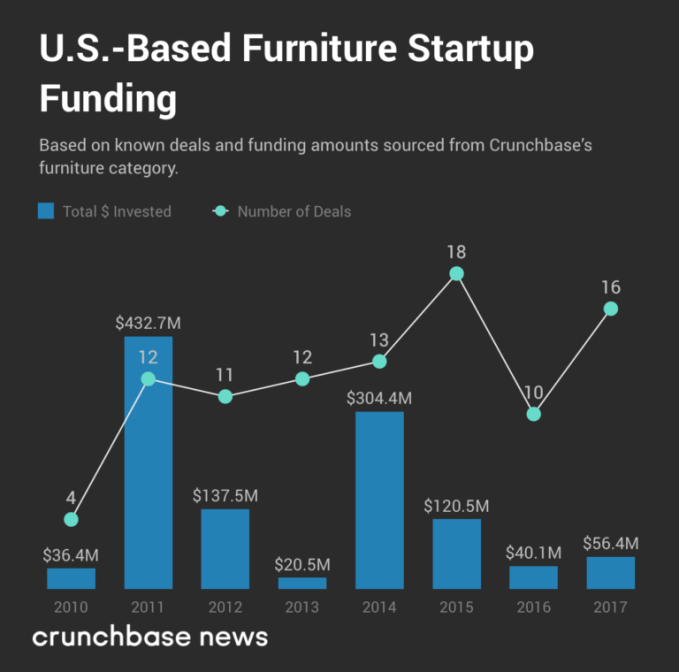
Total dollars funneled into U.S.-based furniture startups, according to Crunchbase, hit an all-time high of $432.7 million across 12 rounds in 2011. Wayfair, an e-commerce site dedicated to selling furniture, raised a significant $165 million Series A that year, accounting for more than a third of the total deal volume.
But while funding hasn’t surpassed 2011 levels, from that year through 2015, round counts steadily climbed. During this period, investments into seed and early-stage startups made up more than 70 percent of known deals.
Whether or not this cohort of seed and early-stage startups will act as fodder for late-stage investors is not yet clear. Before that happens, Stephen Kuhl thinks that there’s more work to be done.
Kuhl, the CEO of Burrow, a company that sells furniture over the internet, told Crunchbase News that “selling traditional furniture made in China or Mexico isn’t innovative, and as such we wouldn’t expect to see a lot of venture funding.” But that doesn’t mean that venture interest in the sector is doomed. Kuhl added that “a new company has to offer a unique product, experience and brand that is altogether [10 times] better than traditional offerings. Expect the money to follow the new brands that truly shake up the status quo.”
That may bear out. The funding data we examined tells one particular story: venture money has shown a preference for delivery and a consumer that doesn’t easily call the place they live in “home.”
For city dwellers, modular, utilitarian couches are taking hold. And it’s increasingly clear you don’t have to leave your couch to purchase one.
Let’s return to Burrow, which has raised a total of $19.2 million, according to Crunchbase. The startup has created a modular couch built for those who live in dense urban environments and may move often.
“Our customers are reflective of larger trends in the market. They’re more likely to be renters rather than homeowners,” Kuhl explained. “They’re likely to move multiple times over the course of a few years, and they crave thoughtful, high-quality goods.”
To account for this new type of customer, Burrow delivers each section of the couch in distinct packages. Burrow claims on its website that its direct to consumer business model and its ability to ship parts of couches, rather than one whole couch, removes “over 70 [percent] of standard shipping costs.” The couch also includes modern amenities such as a USB charger, and Burrow has also “launched an AR app that helps customers visualize a Burrow in their home,” according to Kuhl.
However, Burrow isn’t completely eschewing the showroom as part of its selling strategy. In a podcast interview with TotalRetail, Kuhl noted that the startup has “partner showrooms” in co-working spaces and other retail locations in more than 20 cities.
Of course, while modular design is helpful for city dwellers, there are those who enjoy a bit more of a personal twist. Interior Define, a Chicago-based startup, has raised $27.2 million to offer direct to consumer couches and dining room sets. And, according to Interior Define’s founder Rob Royer, its appeal is being driven by a new breed of consumers who are interested in brands that have “an authentic mission, deliver on a promised experience, and offer a real value proposition (not just a lower price).”
That said, both of these options still require that the furniture be owned — an unnecessary burden if you move often or just like fresh looks without the commitment. Through Feather, customers can subscribe to a whole living room, bedroom or dining room for as low as $35 a month. According to Crunchbase, the New York-based startup has raised $3.5 million from established venture firms such as Y Combinator and Kleiner Perkins.
There are also startups looking to simply help brands sell more furniture by using artificial intelligence and augmented reality. One such startup, Grokstyle, has raised $2.5 million for an app that identifies furniture by image as well as style and pricing preferences.
In general, streets, kitchens and even front doors are being claimed by venture-backed startups. What you sit on might as well be paid for, in part, by venture capitalists, too.
Powered by WPeMatico
Fortnite Battle Royale has swept the gaming world. Alongside its 125 million users and record-breaking Twitch streams, the game has also drawn many competitive players away from their usual titles to try their hand at Battle Royale.
Today, that competitive play reaches at inflection point. At 4pm ET, Fortnite Battle Royale’s Summer Skirmish will kick off, with $8 million going to tournament winners over the course of the competition, with a whopping $250K going to the winners of today’s tournament.
This isn’t the first competitive Fortnite tournament we’ve seen. Celebrity Twitch streamer Ninja held a charity tournament in April, and Epic held a ProAm tournament combining competitive players and celebs who play Fortnite in June. Plus, sites like UMG and CMG have been holding smaller tournaments since Fortnite first rose to popularity. And then there are $20K Fortnite Friday tournaments for streamers held by UMG.
But today, the ante has most certainly been upped. This will be one of the highest paying Fortnite tournaments to date, and is yet just a small fraction of Epic Games’ promised $100 million prize pool for competitive play this year.
For some context, Dota 2 (previously the biggest competitive esports title out there) had a $25 million payout for the International Championship tournament in 2017, with the winners taking home $10.8 million. Call of Duty, one of the most popular titles over the last decade, is only paying out $1.5 million for its own Champs tournament this summer.
In other words, Fortnite is catching up quickly to the competitive gaming scene, not only in terms of talent but money. Epic Games’ Fortnite pulled in a record-breaking $318 million in June alone. In fact, Battle Royale is generating so much revenue for Epic that the company is now only taking a 12 percent share of earnings from its Unreal Marketplace.
But with that growth comes increased scrutiny. Though the company is passing along its fortunes to developers on the Unreal Engine and competitive players, some have noticed situations in which Epic might have been a bit stingy.
Fortnite should put the actual rap songs behind the dances that make so much money as Emotes. Black creatives created and popularized these dances but never monetized them. Imagine the money people are spending on these Emotes being shared with the artists that made them
— Chance The Rapper (@chancetherapper) July 13, 2018
The stream for Fortnite Summer Skirmish begins at 4pm ET and is embedded below:
Watch live video from Fortnite on www.twitch.tv
Powered by WPeMatico